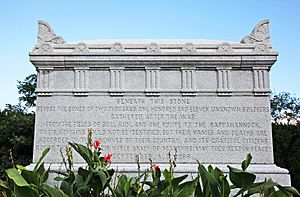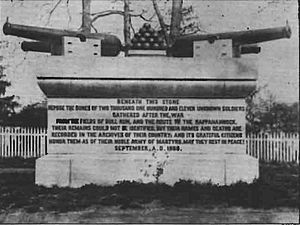Civil War Unknowns Monument facts for kids
Quick facts for kids Civil War Unknowns Monument |
|
|---|---|
| United States | |

West face of the Civil War Unknowns Monument
|
|
| For the unknown dead of the American Civil War | |
| Unveiled | 1865 |
| Location | 38°52′49″N 77°04′23″W / 38.880416°N 77.073183°W near Arlington, Virginia, U.S.
|
The Civil War Unknowns Monument is a special place that honors soldiers who died in the American Civil War but could not be identified. It's like a big underground room (a burial vault) and a memorial stone. This monument is found at Arlington National Cemetery in Arlington, Virginia. It was designed by a military leader named Montgomery C. Meigs and built in 1865.
Many people think the monument is in the middle of a flower garden. But it's actually just west of the garden, in an area that used to be filled with oak and elm trees.
Contents
What Is the History of This Special Place?
How Arlington House Was Built and "The Grove" Area
In 1778, a man named John Parke Custis bought a huge piece of land, about 1,100 acres, near the Potomac River in Virginia. This land became known as the Arlington Estate. After John Custis died, his son, George Washington Parke Custis, inherited the land in 1799. George Washington Parke Custis was the step-grandson of George Washington.
G.W.P. Custis and his wife, Mary, moved to the estate. Between 1802 and 1814, they built a large house called Arlington House. They also created beautiful gardens and landscapes around the house. To the east, they made a large, cultivated English-style garden. South of the house, they planted a big flower garden with a covered walkway.
To the west of Arlington House, there was a natural area with many trees that the Custises called "the Grove." This area was about 60 feet west of the flower garden. It had tall elm and oak trees that formed a shady canopy. The Custis daughters planted an informal flower garden under these trees. We don't know exactly when "the Grove" was first developed, but it was definitely being used by 1853.
G.W.P. Custis's daughter, Mary Anna Randolph Custis, married Robert E. Lee in 1831. Robert E. Lee was a lieutenant in the United States Army at the time. The Lees lived at Arlington House. Mary Custis, G.W.P.'s wife, died in 1853 and was buried in "the Grove." G.W.P. Custis died in 1857 and was buried next to his wife.
How Arlington Became a Cemetery
The history of Arlington Estate changed when the American Civil War began. Robert E. Lee left the United States Army in April 1861 and became a leader of Virginia's armed forces. Union forces (those loyal to the United States) realized that if they put cannons on the high ground of the estate, they could easily attack Washington.
Knowing her home would likely be taken, Mary Custis Lee packed her belongings and left in May 1861. Union troops then took over Arlington Estate and Arlington House on May 24.
In July 1862, the United States Congress passed a law to buy land for national cemeteries for soldiers who died in the war. The U.S. Army's Quartermaster General was put in charge of this program. By late 1863, other cemeteries in the D.C. area were full. In May 1864, many Union soldiers died in the Battle of the Wilderness.
Quartermaster General Montgomery C. Meigs ordered his staff to find a new, large national military cemetery. Within weeks, they said Arlington Estate was the best place. It was high up, safe from floods, had a view of Washington, D.C., and looked nice. It was also the home of the leader of the Confederate forces, Robert E. Lee. This meant Lee could not use his home after the war, which was a political advantage for the Union.
Even though the first soldier was buried at Arlington on May 13, Meigs officially allowed burials to start on June 15, 1864. At first, most burials were in the northeast part of the estate. But in mid-June 1864, Meigs ordered burials to begin near Arlington House itself. The first officer was buried next to the main flower garden on May 17. Within a month, 44 more officers were buried nearby.
In December 1865, Robert E. Lee's brother visited Arlington House. He thought the house could be lived in again if the graves around the flower garden were moved. Meigs disliked Lee for leaving the Union. So, he ordered even more burials near the house. This made it impossible to move the graves later.
Building the Monument for Unknown Soldiers
By 1865, much of "the Grove" had changed. Its flower beds and paths were ruined by soldiers and animals. Some trees were cut down. That year, Meigs decided to build a monument for Civil War dead in the middle of "the Grove."
U.S. Army troops were sent to battlefields within 35 miles of Washington, D.C. They collected the bodies of 2,111 Union and Confederate soldiers. Most came from the battlefields of First and Second Bull Run. Many of these bodies were unburied or only partial remains. None of them could be identified. Even though Meigs didn't plan to collect Confederate remains, it was impossible to tell them apart. So, both Union and Confederate soldiers were buried together under the monument.
Army engineers cut down trees in the eastern part of "the Grove," leaving only a small group of trees to the west. They dug a circular pit about 20 feet wide and 20 feet deep. The pit's walls and floor were lined with brick and divided into sections. Different body parts were placed into each section, like skulls, legs, and arms. The vault was about half full when it was ready to be sealed in September 1866. It was then covered with concrete and soil.
Meigs designed a monument to sit on top of the burial vault. It was a 6-foot tall, 12-foot long, and 4-foot wide stone structure made of grey granite and concrete. On the west side, there was an inscription. It described how many unknown soldiers were in the vault and honored them.
Originally, a large cannon (a Rodman gun) was placed at each corner of the monument. A pyramid of cannonballs was in the center of the top. A circular path, 45 feet from the monument's center, allowed people to walk around it. Paths also led east to the flower garden and west to a road. Grass was planted around the monument, and flower beds were filled with plants that bloom every year.
How the Monument Has Changed Over Time
By 1893, the monument looked very different. The plain sides were replaced with more decorative ones, but the original inscription stayed. The top was changed to look like the Ark of the Covenant described in the Book of Exodus in the Hebrew Bible. The Rodman guns were placed muzzle-down into the ground. The large pyramid of cannonballs was removed from the top. Instead, four small pyramids of cannonballs were placed on either side of the paths leading to the monument.
The monument was also raised higher. It now sat on a slightly larger base made of rough, dark grey granite blocks, about 3 feet high. On top of this, there was a second base of large, light grey granite slabs, about 1 foot high. A third base, a single light grey granite slab, was placed on top of the second. This third base was a bit smaller than the first two but still larger than the monument itself.
Four light grey granite sections, about 6 to 9 inches high, were added to the top of the original sides. These sections were decorated with pilasters (flat columns). The new cover of the monument was a single large, light grey granite slab. Twenty-two small, round stars were added above the edge of the lid. Four decorative fleur-de-lis symbols faced outward at each corner. The top of the lid was rounded. The entire monument became about 12 feet high at its tallest point.
The Civil War Unknowns Monument also inspired Montgomery Meigs' own tomb. He built a similar stone monument over his wife's grave at Arlington National Cemetery. He was buried there himself in 1892.
Images for kids




